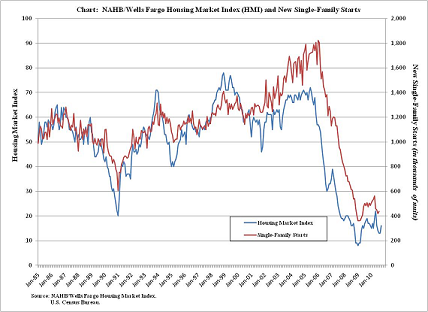Let me ask a simple question. Would you like to buy into one of the biggest sectors of the U.S. economy at 20 year lows?
I would. Housing typically contributes well in excess of 10 percent of U.S. total production, and home equity tends to be the largest part of a household's net worth. Now, home values are down, households have less equity, and homebuilders see a dim, but improving, future.
The National Association of Home Builders (NAHB)/Wells Fargo housing market index (HMI) hit a high of 78 in December of 1998 and managed to stay largely above 70 for the entirety of 1999, but it's been all downhill from there. The following chart shows the HMI index in blue - note that the scale for this metric is on the left side.


The index is a compilation of three components - sales expectations, traffic of prospective buyers, and current sales conditions. In October, all three rose. The takeaway message is that builders are becoming more confident about the future of their industry - although only marginally so.
The last time the index was at such depressed levels was in the beginning of 1991 - almost 20 years ago.
Beaten down, battered, and at multi-decade lows. When would there be a better time to start increasing exposure?
***This type of situation is exactly what contrarian investors look for. They avoid the 'hot' sectors, and the high-flying stocks. Nothing seems to make investors forget about risk like a stock that is on a one way trip to the moon. But those rides never last forever...
Stocks that seem to carry higher risk - like a stock with exposure to the housing sector that I picked up a few months ago - can actually have far less risk than flavor of the month stocks. That's because when you hit rock bottom, there's only one direction left to go.
When it appeared that the American automobile industry was dead in early 2009 Ford (NYSE: F) was an unpopular investment. Shares sank below $2. But a year and a half later the automobile industry has staged a moderate recovery - and shares of Ford have risen over 900 percent to surpass $18 per share.
Right now housing and construction is a sector of the economy that is in even worse shape than the U.S. automobile industry. In fact, this sector is widely believed to have caused the worst recession since the 1930's.
Yet construction spending is increasing, and housing is as affordable as it's been in decades.
I love shopping in the discount isle - where everything is going for fire-sale prices and the bad news is already priced in.
I'm going to be honest with you - things can always get worse. So while I'm recommending this contrarian investment in the housing and construction industry, it's not for everybody.
But that's what a contrarian investment is all about. Be greedy when others are fearful.
That said - we're not walking into this investment without a plan. I believe the stock's upside potential far outweighs the downside risk at this point. Soon more investors will realize that this company isn't completely dependent on a housing recovery. Instead, growth will come from selling energy technology and adding value to low cost energy sources like coal.
If you're comfortable being greedy when others are fearful than I encourage you to click here to try a trial subscription to Small Cap Investor PRO and read my research report on this stock.
Subscribers are already up more than 40 percent on this investment - but I believe shares could double in the next 12 months as the economy continues to improve.
© 2024 Benzinga.com. Benzinga does not provide investment advice. All rights reserved.
Comments
Trade confidently with insights and alerts from analyst ratings, free reports and breaking news that affects the stocks you care about.